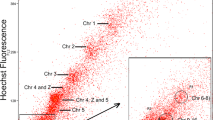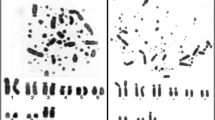Abstract
Palaeognathous birds (Struthioniformes and Tinamiformes) have morphologically conserved karyotypes and less differentiated ZW sex chromosomes. To delineate interspecific chromosome orthologies in palaeognathous birds we conducted comparative chromosome painting with chicken (Gallus gallus, GGA) chromosome 1–9 and Z chromosome paints (GGA1–9 and GGAZ) for emu, double-wattled cassowary, ostrich, greater rhea, lesser rhea and elegant crested tinamou. All six species showed the same painting patterns: each probe was hybridized to a single pair of chromosomes with the exception that the GGA4 was hybridized to the fourth largest chromosome and a single pair of microchromosomes. The GGAZ was also hybridized to the entire region of the W chromosome, indicating that extensive homology remains between the Z and W chromosomes on the molecular level. Comparative FISH mapping of four Z- and/or W-linked markers, the ACO1/IREBP, ZOV3 and CHD1 genes and the EE0.6 sequence, revealed the presence of a small deletion in the proximal region of the long arm of the W chromosome in greater rhea and lesser rhea. These results suggest that the karyotypes and sex chromosomes of palaeognathous birds are highly conserved not only morphologically, but also at the molecular level; moreover, palaeognathous birds appear to retain the ancestral lineage of avian karyotypes.
Similar content being viewed by others
References
Ansari HA, Takagi N, Sasaki M (1988) Morphological differentiation of sex chromosomes in three species of ratite birds. Cytogenet Cell Genet 47: 185–188.
Belterman RHR, de Boer LEM (1984) A karyological study of 55 species of birds, including karyotypes of 39 species new to cytology. Genetica 65: 39–82.
Belterman RHR, de Boer LEM (1990) A miscellaneous collection of bird karyotypes. Genetica 83: 17–29.
Carter NP, Ferguson-Smith MA, Perryman MT et al. (1992) Reverse chromosome painting: a method for the rapid analysis of aberrant chromosomes in clinical cytogenetics. J Med Genet 29: 299–307.
Chowdhary BP, Raudsepp T (2000) HSA4 and GGA4: remarkable conservation despite 300-Myr divergence. Genomics 64: 102–105.
Cracraft J (2001) Avian evolution, Gondwana biogeography and the Cretaceous–Tertiary mass extinction event. Proc R Soc Lond B 268: 459–469.
de Boer LEM (1980) Do the chromosomes of the kiwi provide evidence for a monophyletic origin of the ratites? Nature 287: 84–85.
de Kloet SR (2002) Molecular sex identification of tinamous with PCR using primers derived from the spindlin gene. Mol Ecol Notes 2: 465–466.
de Kloet RS, de Kloet SR (2003) Evolution of the spindlin gene in birds: independent cessation of the recombination of sex chromosomes at the spindlin locus in neognathous birds and tinamous, a palaeognathous avian family. Genetica 119: 333–342.
de Oliveira EHC, Habermann FA, Lacerda O, Sbalqueiro IJ, Wienberg J, Müller S (2005) Chromosome reshuffling in birds of prey: the karyotype of the world’s largest eagle (Harpy eagle, Harpia harpyja) compared to that of the chicken (Gallus gallus). Chromosoma 114: 338–343.
Derjusheva S, Kurganova A, Habermann F, Gaginskaya E (2004) High chromosome conservation detected by comparative chromosome painting in chicken, pigeon and passerine birds. Chromosome Res 12: 715–723.
Fridolfsson A-K, Ellegren H (1999) A simple and universal method for molecular sexing of non-ratite birds. J Avian Biol 30: 116–121.
García-Moreno J, Mindell DP (2000) Rooting a phylogeny with homologous genes on opposite sex chromosomes (gametologs): a case study using avian CHD. Mol Biol Evol 17: 1826–1832.
Griffin DK, Haberman F, Masabanda J et al. (1999) Micro- and macrochromosome paints generated by flow cytometry and microdissection: tools for mapping the chicken genome. Cytogenet Cell Genet 87: 278–281.
Griffin DK, Robertson LBW, Tempest HG, Skinner BM (2007) The evolution of the avian genome as revealed by comparative molecular cytogenetics. Cytogenet Genome Res (In press).
Griffiths R, Daan S, Dijkstra C (1996) Sex identification in birds using two CHD genes. Proc R Soc Lond B 263: 1251–1256.
Guttenbach M, Nanda I, Feichtinger W, Masabanda JS, Griffin DK, Schmid M (2003) Comparative chromosome painting of chicken autosomal paints 1–9 in nine different bird species. Cytogenet Genome Res 103: 173–184.
Hedges SB, Poling LL (1999) A molecular phylogeny of reptiles. Science 283: 998–1001.
Howell WM, Black DA (1980) Controlled silver-staining of nucleolus organizer regions with a protective colloidal developer: a 1-step method. Experientia 36: 1014–1015.
International Chicken Genome Sequencing Consortium (2004) Sequence and comparative analysis of the chicken genome provide unique perspectives on vertebrate evolution. Nature 432: 695–716.
Itoh Y, Arnold AP (2005) Chromosomal polymorphism and comparative painting analysis in the zebra finch. Chromosome Res 13: 47–56.
Janke A, Arnason U (1997) The complete mitochondrial genome of Alligator mississippiensis and the separation between recent Archosauria (birds and crocodiles). Mol Biol Evol 14: 1266–1272.
Kasai F, Garcia C, Arruga MV, Ferguson-Smith MA (2003) Chromosome homology between chicken (Gallus gallus domesticus) and the red-legged partridge (Alectoris rufa); evidence of the occurrence of a neocentromere during evolution. Cytogenet Genome Res 102: 326–330.
Kumar S, Hedges SB (1998) A molecular timescale for vertebrate evolution. Nature 392: 917–920.
Kumazawa Y, Nishida M (1999) Complete mitochondrial DNA sequences of the green turtle and blue-tailed mole skink: statistical evidence for Archosaurian affinity of turtles. Mol Biol Evol 16: 784–792.
Mannen H, Li SS-L (1999) Molecular evidence for a clade of turtles. Mol Phyl Evol 13: 144–148.
Masabanda JS, Burt DW, O'Brien PC et al. (2004) Molecular cytogenetic definition of the chicken genome: the first complete avian karyotype. Genetics 166: 1367–1373.
Matsuda Y, Chapman VM (1995) Application of fluorescence in situ hybridization in genome analysis of the mouse. Electrophoresis 16: 261–272.
Matsuda Y, Nishida-Umehara C, Tarui H et al. (2005) Highly conserved linkage homology between birds and turtles: birds and turtle chromosomes are precise counterparts of each other. Chromosome Res 13: 601–615.
McQueen HA, Fantes J, Cross SH, Clark VH, Archibald AL, Bird AP (1996) CpG islands of chicken are concentrated on microchromosomes. Nature Genet 12: 321–324.
McQueen HA, Siriaco G, Bird AP (1998) Chicken microchromosomes are hyperacetylated, early replicating, and gene rich. Genome Res 8: 621–630.
Nanda I, Karl E, Volobouev V, Griffin DK, Schartl M, Schmid M (2006) Extensive gross genomic rearrangements between chicken and Old World vultures (Falconiformes: Accipitridae). Cytogenet Genome Res 112: 286–295.
Nishida-Umehara C, Fujiwara A, Ogawa A, Mizuno S, Abe S, Yoshida MC (1999) Differentiation of Z and W chromosomes revealed by replication banding and FISH mapping of sex-chromosome-linked DNA markers in the cassowary (Aves, Ratitae). Chromosome Res 7: 635–640.
Ogawa A, Murata K, Mizuno S (1998) The location of Z- and W-linked marker genes and sequence on the homomorphic sex chromosomes of the ostrich and the emu. Proc Natl Acad Sci USA 95: 4415–4418.
Paton T, Haddrath O, Baker AJ (2002) Complete mitochondrial DNA genome sequences show that modern birds are not descended from transitional shorebirds. Proc R Soc Lond B 269: 839–846.
Pigozzi MI, Solari AJ (1997) Extreme axial equalization and wide distribution of recombination nodules in the primitive ZW pair of Rhea americana (Aves, Ratitae). Chromosome Res 5: 421–428.
Pigozzi MI, Solari AJ (1999) The ZW pairs of two paleognath birds from two orders show transitional stages of sex chromosome differentiation. Chromosome Res 7: 541–551.
Pigozzi MI, Sorali AJ (2005) Meiotic recombination in the ZW pair of a tinamid bird shows a differential pattern compared with neognaths. Genome 48: 286–290.
Raudsepp T, Houck ML, O'Brien PC, Ferguson-Smith MA, Ryder OA, Chowdhary BP (2002) Cytogenetic analysis of California condor (Gymnogyps californianus) chromosomes: comparison with chicken (Gallus gallus) macrochromosomes. Cytogenet Cell Genet 98: 54–60.
Sasaki M, Nishida C, Takagi N, Hori H (1980) Sex-chromosomes of the elegant crested tinamou, Eudromia elegans (Aves: Tinamiformes: Tinamidae). Chromosome Info Serv 29: 19–21.
Sasaki M, Takagi N, Nishida C (1984) Current profiles of avian cytogenetics, with notes on chromosomal diagnosis of sex in birds. Nucleus 27: 63–73.
Schmid M, Nanda I, Guttenbach M et al. (2000) First report on chicken genes and chromosomes 2000. Cytogenet Cell Genet 90: 169–218.
Schmid M, Enderle E, Schindler D, Schempp W (1989) Chromosome banding and DNA replication patterns in bird karyotypes. Cytogenet Cell Genet 52: 139–146.
Shetty S, Griffin DK, Graves JAM (1999) Comparative painting reveals strong chromosome homology over 80 million years of bird evolution. Chromosome Res 7: 289–295.
Shibusawa M, Minai S, Nishida-Umehara C et al. (2001) A comparative cytogenetic study of chromosome homology between chicken and Japanese quail. Cytogenet Cell Genet 95: 103–109.
Shibusawa M, Nishida-Umehara C, Masabanda J, Griffin DK, Isobe T, Matsuda Y (2002) Chromosome rearrangements between chicken and guinea fowl defined by comparative chromosome painting and FISH mapping of DNA clones. Cytogenet Cell Genet 98: 225–230.
Shibusawa M, Nishida-Umehara C, Tsudzuki M, Masabanda J, Griffin DK, Matsuda Y (2004a) A comparative karyological study of the blue-breasted quail (Coturnix chinensis, Phasianidae) and California quail (Callipepla californica, Odontophoridae). Cytogenet Genome Res 106: 82–90.
Shibusawa M, Nishibori M, Nishida-Umehara C et al. (2004b) Karyotypic evolution in the Galliformes: an examination of the process of karyotypic evolution by comparison of the molecular cytogenetic findings with the molecular phylogeny. Cytogenet Genome Res 106: 111–119.
Sibley CG, Ahlquist JE (1990) Phylogeny and Classification of Birds: A study in molecular evolution. New Haven: Yale University Press.
Sumner AT (1972) A simple technique for demonstrating centromeric heterochromatin. Exp Cell Res 75: 304–306.
Suzuki T, Kurosaki T, Shimada K et al. (1999) Cytogenetic mapping of 31 functional genes on chicken chromosomes by direct R-banding FISH. Cytogenet Cell Genet 87: 32–40.
Takagi N, Sasaki M (1974) A phylogenetic study of bird karyotypes. Chromosoma 46: 91–120.
Takagi N, Itoh M, Sasaki M (1972) Chromosome studies in four species of Ratitae (Aves). Chromosoma 36: 281–291.
Tsuda Y, Nishida-Umehara C, Ishijima J, Yamada Y, Matsuda Y (2007) Comparison of the Z and W sex chromosomal architectures in elegant crested tinamou (Eudromia elegans) and ostrich (Struthio camelus) and the process of sex chromosome differentiation in palaeognathous birds. Chromosoma 116: 159–173.
van Tuinen M, Hedges SB (2001) Calibration of avian molecular clock. Mol Biol Evol 18: 206–213.
van Tuinen M, Sibley CG, Hedges SB (1998) Phylogeny and biogeography of ratite birds inferred from DNA sequences of the mitochondrial ribosomal genes. Mol Biol Evol 15: 370–376.
van Tuinen M, Sibley CG, Hedges SB (2000) The early history of modern birds inferred from DNA sequences of nuclear and mitochondrial ribosomal genes. Mol Biol Evol 17: 451–457.
Author information
Authors and Affiliations
Corresponding author
Rights and permissions
About this article
Cite this article
Nishida-Umehara, C., Tsuda, Y., Ishijima, J. et al. The molecular basis of chromosome orthologies and sex chromosomal differentiation in palaeognathous birds. Chromosome Res 15, 721–734 (2007). https://doi.org/10.1007/s10577-007-1157-7
Received:
Revised:
Accepted:
Published:
Issue Date:
DOI: https://doi.org/10.1007/s10577-007-1157-7




